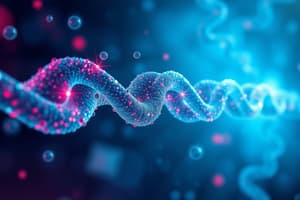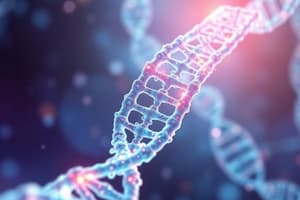Podcast
Questions and Answers
What is the purpose of PCR?
What is the purpose of PCR?
- To purify DNA templates
- To amplify specific DNA sequences (correct)
- To synthesize RNA strands
- To analyze PCR products on an agarose gel
What is the function of primers in PCR?
What is the function of primers in PCR?
- To purify DNA templates
- To synthesize DNA strands
- To provide the chemical conditions for the reaction
- To bind to the 3' ends of the sequence being amplified (correct)
What are the components of PCR?
What are the components of PCR?
- RNA template, primers, RNA polymerase, and a solution with the right chemical conditions for the reaction
- DNA template, primers, RNA polymerase, and a solution with the right chemical conditions for the reaction
- DNA template, primers, DNA helicase, and a solution with the right chemical conditions for the reaction
- DNA template, primers, DNA polymerase, and a solution with the right chemical conditions for the reaction (correct)
What is the purpose of retrotranscripted PCR?
What is the purpose of retrotranscripted PCR?
What is the β-actin gene and why is it ideal as a reference gene?
What is the β-actin gene and why is it ideal as a reference gene?
What does the threshold cycle (Ct) in RT-PCR represent?
What does the threshold cycle (Ct) in RT-PCR represent?
What is the purpose of qPCR?
What is the purpose of qPCR?
Flashcards are hidden until you start studying
Study Notes
PCR and its Applications in Molecular Biology
- PCR is a widely used molecular biology technique that amplifies specific DNA sequences.
- PCR uses DNA polymerase to synthesize DNA strands by adding nucleotides to annealed nucleotides.
- PCR requires short fragments called primers, which are complementary to the 3' ends of the sequence being amplified.
- PCR can produce millions of copies of DNA starting from a small amount of DNA template in a relatively short period of time.
- The components of PCR include DNA template, primers, DNA polymerase, and a solution with the right chemical conditions for the reaction.
- PCR cycles involve denaturation, annealing, and primer extension, and are repeated to produce copies of the exact product being looked for.
- Retrotranscripted PCR is a semi-quantitative technique used to measure gene expression levels relative to another gene, typically a stable housekeeping gene.
- Retrotranscripted PCR involves mRNA purification, cDNA synthesis, PCR with cDNA as a template, and analysis of PCR products on an agarose gel.
- The β-actin gene is a housekeeping gene and its expression is equal in all organs, making it ideal as a reference gene for comparison with other genes expressed only in some organs.
- RT-PCR provides the ratio of the amount of mRNA between two samples, but not the exact number of copies of the gene expressed.
- The threshold cycle (Ct) is the cycle at which the amount of product is significantly higher than the baseline and is the point where differences between all samples can be measured.
- QPCR, also called qPCR, uses a fluorescent chemical compound that emits high emission when bound to double-strand DNA and not when bound to single-strand DNA, allowing for the detection of PCR products in real-time.
Studying That Suits You
Use AI to generate personalized quizzes and flashcards to suit your learning preferences.




